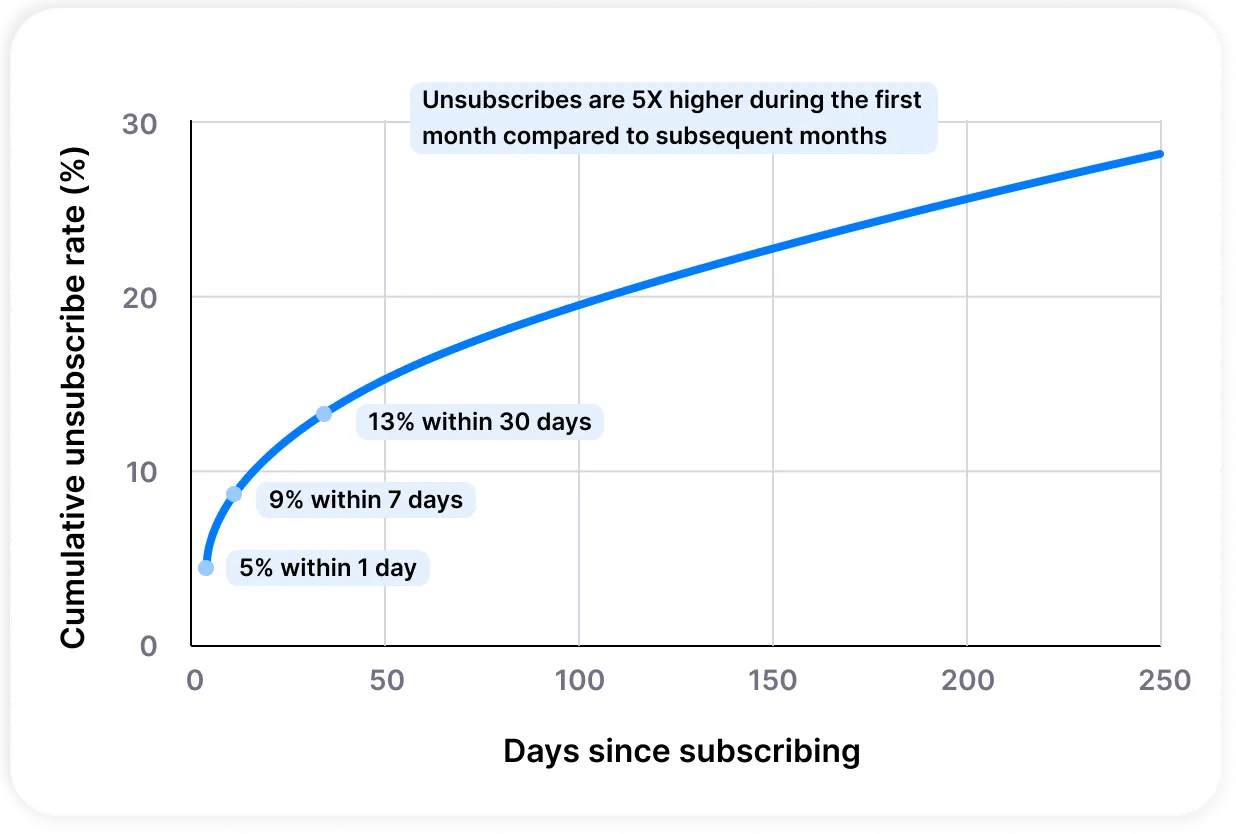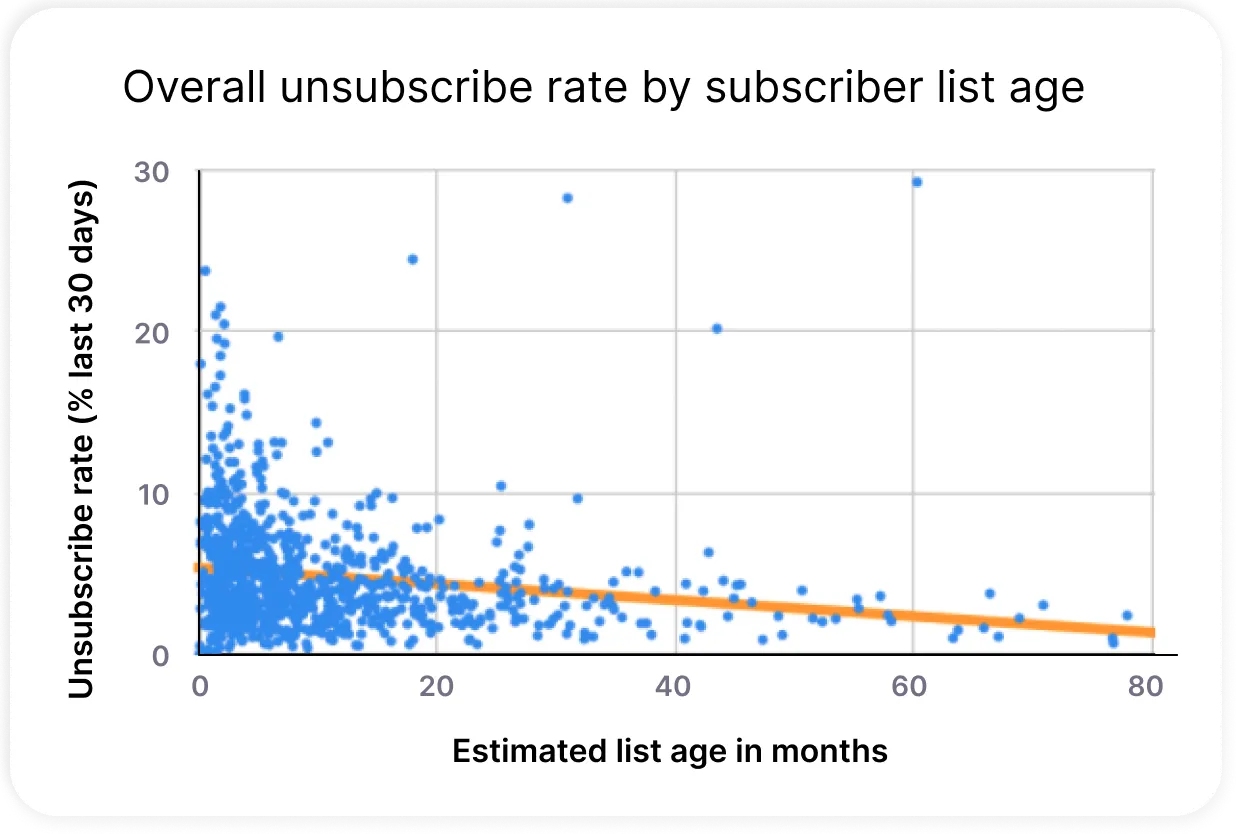
6 Surprising Facts About SMS Unsubscribes
Unsubscribes happen. No matter how personalized your messaging or how great your creative, some folks are going to churn out of your list—and that’s perfectly normal.
In fact, you actually want unengaged subscribers to opt out. Otherwise, you’re paying to message people who will probably never convert. Engaged subscribers, on the other hand, are the holy grail of SMS marketing: you want to retain as many of them as possible for as long as possible.
So, it’s important to understand the real reasons people leave your list—as well as the myths that may prevent you from getting the most value out of your subscribers. With that in mind, let’s dive into 6 surprising facts about unsubscribes that may change the way you think about your messaging strategy.
Unsubscribe rates are 5 times higher during the first 30 days after SMS opt-in than they are at any other point during the subscriber lifecycle.

In other words, newer subscribers are more likely to churn than older subscribers. This might seem counterintuitive, especially if you’re used to managing email unsubscribes. With SMS, a subscriber’s tolerance for messaging that does not resonate with their needs and interests is very low—and it doesn’t take them long to make the call on whether they want to continue receiving texts from a particular brand.
The “discount and ditch” mentality comes into play here—some subscribers are just in it for the incentive.
Either way, this underscores the importance of your messaging strategy immediately after a new subscriber joins your list. (More on that in a bit!)
The older your SMS subscriber list, the lower your unsubscribe rate.
This one might also seem a bit backwards to marketers who are familiar with the signals of a healthy email list. Building on the previous fact, once a subscriber gets past their first 30 days, they’re much more likely to stay subscribed than they are to unsubscribe in the long term.
So, if you’re doing a good job nurturing folks past the one-month mark and keeping unsubscribes low during that time, then you’re doing a good job building a healthy and engaged list for the future. That means you’re not likely to see any spikes in unsubscribe rates as your SMS program ages.

Welcome series messages are the key to reducing unsubscribes in both the short and long term.
Okay, now that we’ve established why it’s so important to retain new subscribers during their first 30 days, let’s talk about how to do it.
For those who opt in to receive an incentive (e.g., via an onsite popup or keyword campaign), the initial opt-in flow providing the discount shouldn’t be the only messaging they receive from your brand during their first 30 days—regardless of whether they convert.
Obviously you want to give them the opportunity to buy—and maybe even follow up with a reminder to use their discount—but to drive long-term retention, you also need to set expectations and ensure you deliver an engaging, high-quality experience. Remember, you only get one chance to make a first impression!
This is where your welcome series comes in. This flow of 2–4 messages should be used to:
Introduce new subscribers to your brand’s products, mission, founders, and/or origin story.
Inform subscribers of what sort of messages they can expect to receive from you.
Ask subscribers about their interests or the types of messages they would like to receive from you (e.g., by sending a list of keywords and asking them to text back the ones that resonate most). Hint: This is a great strategy for funneling those who are only interested in receiving messages about sales and discounts into a separate list that you can exclude from non-sales campaigns.
Whatever you include in your welcome series, keep it super high-value. We’d also recommend excluding brand-new subscribers from evergreen campaign messages (e.g., educational content or feedback requests) until they make it all the way through the welcome series. However, if your welcome series includes multiple messages over a longer period of time (say, 6–8 messages in a 20-day window), you’ll still want to include those subscribers in any big campaign sends (like sales or new product drops) so they don’t miss out.
For new subscribers who do convert on an offer, be sure to quickly follow up with post-purchase messaging that demonstrates the value of staying subscribed—usage tips, offers or suggestions for complementary products, information about loyalty programs, etc.
Learn more welcome series strategies and best practices—and see top-notch examples from real brands—in this post.
Sending more messages doesn’t have a substantial impact on unsubscribe rates.

When analyzing unsubscribe data across the Postscript user base, our data team discovered that each additional send resulted in a 0.5% increase in unsubscribes during the first 30 days—not bad considering that an unsubscribe rate of 20% during the first 30 days is considered great.
This means that hypothetically, sending one more message to a list of 1,000 subscribers would result in only 5 additional unsubscribes. Probably way fewer than you’d assume, right? Because SMS is such an intimate and sensitive channel, many brands are worried about over-messaging subscribers, but in reality, the data paints a different picture.
Sending more messages does not automatically lead to major spikes in unsubscribes. This is especially important considering that we’re talking about the first 30 days after a subscriber opts in—prime time for some incredibly high-earning messages.
For instance, as noted in our 2022 SMS Benchmarks report, the EPM (Earnings per Message) for welcome series messages is $1.55–$6.64 across all industries. That’s an approximate median of $4.10.
Going back to the list of 1,000 subscribers noted above—sending one additional welcome series message at an EPM of $4.10 would result in $4,100 in additional revenue.
That’s a pretty big chunk of change—but at what cost? Well, let’s say the Subscriber LTV for this list is $20—right at the “intermediate” threshold of our benchmark data. That would bring the total Subscriber LTV loss to $100 (5 unsubscribes times $20 per subscriber). So, the net gain for the additional welcome series message would still be $4,000.
Losing $100 to make $4,000 doesn’t sound too bad, right? The moral of the story is that you shouldn’t let unsubstantiated fears about unsubscribes hold you back from realizing your full SMS revenue potential. At the very least, test sending that extra message—which brings us to our next surprising fact.
Brands should be able to send each subscriber at least 5 texts per month without increasing unsubscribes.
Through analysis of the more than 7,000 brands using Postscript for SMS marketing, we found that the merchants getting the most out of their SMS programs—including a favorable balance of revenue dollars and unsubscribes—sent 5 or more messages per month.
If your brand is not able to send 5 texts per month without seeing a major negative impact to revenue and unsubscribes, then it’s time to look at your message content and segmentation. High-quality SMS creative and thoughtful segmentation help ensure that subscribers consistently receive engaging, personalized texts from your brand—exactly the kind that they want to receive. If that’s the case, their likelihood of opting out is low. On the other hand, if you’re merely batching and blasting—sending spammy messages to your full list—then it should come as no surprise that unsubscribes will follow.
So, if you’re not already sending each subscriber an average of 5 texts per month, try it. Measure the impact of that change, and adjust your messaging approach accordingly.
Once you reach the 5-messages-per-month threshold, test adding another. If the results are favorable, try one more—and so on—until you find your brand’s “sweet spot.” (Check out our recent product launch event recap for even more great advice on finding your perfect sending cadence.)
A great SMS unsubscribe rate can be up to 100 times higher than a great email unsubscribe rate.
According to our friends at Klaviyo, a great email unsubscribe rate is less than 0.2%. As we mentioned above, a great—or, as we like to say around here, “textpert”—unsubscribe rate is anything under 20%. Talk about a wide gap.
Of course, this isn’t an apples-to-apples comparison, because at Postscript, we specifically measure unsubscribes during the first 30 days (a.k.a. the period when subscribers are the most likely to churn out of your list). But it’s important to get email stats out of your head and look at our recommended benchmarks for SMS unsubscribe rates with totally fresh eyes. Otherwise, targeting an unsubscribe rate of 20% or less might feel strange—but that’s exactly the benchmark you should be shooting for during a subscriber’s first 30 days.
This is just one more fact proving that email subscriber behavior is vastly different from SMS subscriber behavior. Whereas someone might stay subscribed to email communications for several months—or even years—with little to no engagement, SMS subscribers tend to quickly opt out of text messages once they lose interest. This makes sense considering that folks often let hundreds or thousands of emails sit in their inbox unopened and unread—almost as if the effort to open one of those messages and click the unsubscribe link is not worth it. But very few people let text messages sit unread on their phones, so there is greater incentive to stop receiving messages they’re not interested in.
Bottom line: SMS is not like email. They are wholly separate channels with different marketing best practices, subscriber behavior, key metrics—the lot. And that distinction is especially important when talking about unsubscribe rates.
Not all relationships are meant to last, and not all SMS subscribers are meant to make it to LTR status with your brand. Your ultimate goal is building a healthy, engaged, valuable list—one that will make SMS your top revenue-generating channel. Don't Let unfounded fears about unsubscribes stand in your way.



